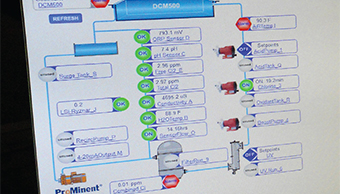
Enhancing an Indoor Pool Environment
by Jim Tanner
By switching to automated water chemistry control based on real-time chlorine levels (ppm), Emler Swim School found an effective solution to a recurring problem.
When parents of young swimmers look out over the pools serving Emler Swim School, Mike Gentry knows they had better see clear, sparkling water.
Maintaining clean, safe pool water at all times is top priority for Gentry, Director of Maintenance – Pool Operations, for Emler Swim School. Emler operates seven schools in and around Dallas and Austin, Texas. All levels of instruction are based on Emler’s award-winning SwimScript© curriculum that is continually updated with new techniques to keep it on the cutting edge of aquatic education.
Maintaining Water Quality
Maintaining clear, safe pool water at all times is a top priority for Emler Swim School. The school is one of the few pool facilities in the Dallas area that has invested in Ultraviolet (UV) Light disinfection systems. Medium pressure UV systems are used for both eradication of micro-organisms and chloramine removal.
Difficulties maintaining properly balanced water chemistry can bring numerous problems to indoor pool facilities, so Gentry was concerned when chlorine levels in the pool at Emler’s Frisco facility began to migrate up over the weekends.
 |
“The pool is closed Sundays, but our automated controller was still continuing to generate and feed chlorine during this time, even though the pool was not in use,” he says. “The controller’s ORP sensor seemed to just go blind during these longer periods of inactivity. The system was showing low ORP when chlorine levels were actually very high. We strive to keep our chlorine residual in the 2-3 ppm range, but we were often dealing with upwards of 13-14 ppm chlorine when we came in to work Monday mornings.”
The pool’s water chemistry was being monitored and controlled by a system installed several years earlier to automatically feed chlorine and other chemicals when a change in chlorine (based on ORP) or pH was indicated. “We also always test our pool water manually every hour when instructors and their classes are in the pool,” Gentry says. “But on Sundays we were relying strictly on the controller.”
ORP has long been used as the main indicator for determining how much chlorine is in commercial swimming pool water, but for Gentry this was creating problems. “Everything worked fine for awhile after we installed the controller, but it began giving us trouble due to inaccurate ORP readings. Then, the controllers at some of our other locations began to have similar problems. Chlorine residuals would be fine until we came back in on Mondays. We never seemed to be able to get out of this endless loop.”
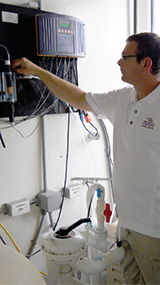 |
Changing Tactics
In January 2012, Gentry replaced the water chemistry controller at the school’s Frisco facility with a completely new system for monitoring and controlling water chemistry. The new system, a ProMinent DCM-502 water chemistry controller, monitors and controls pH, ORP, free chlorine and total chlorine. The control system uses real-time free chlorine and combined chlorine measurements (in ppm) to control chlorine feed and uses combined chlorine readings to control secondary oxidizers such as UV. ORP is also still used as a background measurement as a backup safety component. For example, if ORP drops below a predetermined setpoint, the controller can switch from ppm to ORP control, if desired)
The DCM-502 is one of the first water chemistry controllers in the commercial pool industry that provides an actual, real-time combined chlorine reading. Based on these real-time combined chlorine ppm measurements, water chemistry at Emler Swim School’s Frisco facility was stabilized almost immediately after final calibrations to the system were made.
Due to the success with the new system, the school recently decided to install new DCM- 502 controllers at three additional facilities.
“I like the fact that the chlorine can be controlled from a real-time free chlorine measurement rather than ORP,” Gentry says. “With the new controller we’re now using the actual free chlorine as our guideline measurement and ORP as our assist measurement.”
The new pool water chemistry controller also controls the facility’s UV system based on the real-time combined chlorine reading and other pool chemistry measurements.
“The controller extrapolates the amount of chloramines in the water and automatically turns on the UV to eradicate that bad chlorine,” Gentry says, “so now we don’t have the foul odor you often smell in an indoor pool. We don’t have that bleachy smell or the associated corrosion problems that excessive chloramines can bring.”
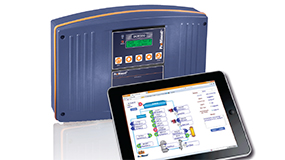 |
Mobility
By switching water chemistry control systems, Gentry also added mobility to his program. The system provides for standard webbased, real-time monitoring and control via a network-enabled PC, smart phone, iPad or other tablet device.
“With our old controllers, we had to physically stand right in front of them to monitor and adjust water chemistry settings, but now I can do this via the Internet from anywhere. There are other controllers that can also do this, but what turned me towards this new unit is the fact that I can also get an actual ppm reading for chlorine. The mobility feature was very important to us in our decision, though. We wanted to be able to access our water chemistry systems from anywhere.”
Gentry currently has the school’s water chemistry controllers set to remotely monitor realtime pH levels, chorine levels, combined chlorine levels, TDS levels and water temperature.
“It will also tell me whether or not my chlorine generator pump and UV system are currently running and how long they have been running” Gentry says. “I also have it set up to tell me the actual temperature of the pool room – the air temperature, at two of our locations.”
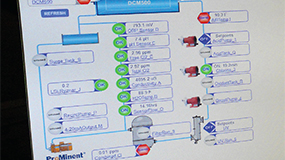 |
Interactive Control
A sample flow from a sidestream is fed to flow cells, where probes read pH, ORP, ppm chlorine and ppm combined chlorine. When the controller reads that free chlorine levels are below the setpoint, additional chlorine is released into the filtered water. Thus, chlorine residual levels are accurately measured and controlled at all times. Programmable alarms notify Gentry and his team if chlorine or pH levels drop below or rise above certain key levels. This provides them with almost immediate notification in the event of an emergency or equipment failure.
“If there are times when I’m away from a site but see on my computer that pH might be reading a little bit off, for example, I can call the technician at the facility and have them take a couple of tests and let me know the results at 30-minute intervals. It might turn out that I simply need to calibrate the system on my end, which eliminates a trip for me. The mobility provided by the new control systems makes this really nice.”
The ProMinent DCM-502 is also designed to control backwash and filter operations, although Emler Swim School has not yet included those functions in its operations. “We want to become as familiar as possible with the units before we begin to use more of their functions,” Gentry says.
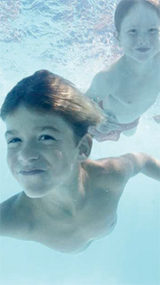 |
Reporting
Another feature Gentry is looking forward to setting up in the system is its Trackster™ auto poll, data logging, graphing and report building software. “It will be great to have documentation readily available via this proprietary software for capturing data,” he says. Controller events such as feeder activity, alarms, and individual operator adjustments can also be recorded.
In addition, all this reporting data will soon be available via cloud technology. No software will be necessary – all the necessary pool information will be available in the cloud.
Reliable automation and remote access is providing superior water quality at Emler Swim School during the intervals of heaviest use as well as during times of inactivity, minimizing maintenance concerns – and providing peace of mind.
About the Author:
Jim Tanner is Director - Aquatic Division, ProMinent Fluid Controls for ProMinent USA. Email: jimt@prominent.us
CLICK HERE to download the pdf version